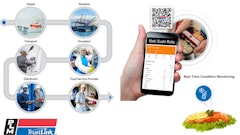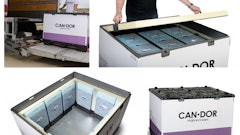
The U.S. EPA SNAP Rule 26 going into effect July 15 is big news for commercial and industrial refrigeration, and in fact, for the whole of the HVACR industry invested in moving A2L refrigerant technology from a “future vision” to a present-day opportunity. SNAP Rule 26 has opened the door for refrigerant manufacturers to commercialize high-performing, significantly lower global warming potential (GWP) A2Ls—specifically, R-454A and R-454C—and for OEMs to manufacture new systems using these refrigerants for commercial and industrial refrigeration applications. Moreover, in aligning with the U.S. EPA American Innovation and Manufacturing (AIM) Act’s Technology Transitions Program, SNAP Rule 26 facilitates a smoother and successful transition to refrigerant innovation with incredible staying power.
While ample resources detail what refrigerants SNAP Rule 26 (Protection of Stratospheric Ozone: Listing of Substitutes Under the SNAP Program in Commercial and Industrial Refrigeration) lists as acceptable substitutes and under what use conditions, some industry professionals need an understanding of the bigger-picture purpose, impact, and opportunities of the rule. This understanding moves the finalization of SNAP Rule 26 from being merely something important to know to a reason for everyone along the cold food and beverage chain to feel excited about the future.
SNAP 101
The Significant New Alternatives Policy (SNAP) Policy was established 30 years ago under Section 612 of the Clean Air Act, which requires the EPA to identify and evaluate substitutes for end uses that historically have utilized ozone-depleting substances. To achieve this, the EPA evaluates a substance’s overall risk to human health and the environment, looking at criteria such as its ozone depletion potential (ODP), global warming potential (GWP), flammability, and toxicity; occupational and consumer health and safety; and environmental risks, such as impact on ecosystems and local air quality.
The SNAP Program provides critical support as initiatives such as the AIM Act continue to phase down production and consumption of hydrofluorocarbon (HFC) refrigerants. As supply of HFC refrigerants decrease, SNAP approvals provide guidance for solutions that not only “fill the gap,” and help establish a foundation for industrywide use of new-generation refrigerants supporting environmental necessities such as reduced energy consumption and lower GWP. To date, the SNAP program has provided a very effective framework for evaluation and approval in support of innovation and the transition to new technology.
SNAP Rule 26
Under SNAP Rule 26, the EPA deems 10 refrigerants as acceptable, subject to use conditions, for various commercial refrigeration applications, including industrial process refrigeration, cold storage warehouses and retail food refrigeration, among others. Six of the refrigerants—R-1234yf, R-1234ze(E), R-454C, R-455A, R-457A, and R-516A—have a GWP under 150. A few refrigerants with a GWP greater than 150—R-454B and R-32, for example—are also listed as acceptable substitutes because their performance characteristics necessitate their use in certain applications. The rule also modifies use conditions for R-290 (propane) and exempts R-290 in refrigerated food processing and dispensing equipment from the venting prohibition.
Because many acceptable substitutes are classified as mildly flammable A2L refrigerants, the EPA incorporates use conditions to ensure safety. These conditions rely upon the latest version of safety standards—UL 60335-2-89 and ASHRAE 15-2022. In addition to following the latest safety standards, it is important to remember that A2Ls will be used in new equipment only. However, for existing equipment utilizing a higher-GWP HFC, there typically is a lower-GWP HFC/HFO non-flammable blend that can be retrofitted into the equipment.
The marriage with sector controls
As regulations under the AIM Act work to achieve a total 85% HFC phasedown—from historic baseline levels—by 2036, the EPA’s Technology Transitions Program will start to impact the industry as early as Jan. 1, 2025. These “sector controls” focus on limiting use of HFC refrigerants and supporting A2L adoption by calling for GWP limits for refrigerants based on specific applications, including commercial and industrial refrigeration. Although the details of Technology Transitions Program rules can be complex, it’s relatively simple to see how the two programs work hand in hand. SNAP Rule 26 lists substitutes that meet the requirements of sector-based GWP limits in commercial refrigeration and other applications specified under Technology Transition rules.
The impact chain
SNAP Rule 29 will first influence refrigerant manufacturers and OEMs. With the approval of several A2Ls as acceptable substitutes under SNAP Rule 26, OEMs now have the green light to use these new-generation refrigerants in new commercial refrigeration systems. Refrigerant manufacturers can also move ahead with the finalization and U.S. commercialization of listed A2L substitutes, many of which have been commercially available and used effectively in Europe for years.
The impact of SNAP Rule 26 will next reach facility managers, store owners, and other decision-makers in commercial and industrial refrigeration, who will have a number of options for replacing equipment with systems offering the lower GWP, greater energy efficiency, high performance, and other attributes associated with A2Ls. Because the EPA purposefully lists several different refrigerants in each application, OEMs can consider a variety of different factors—such as energy efficiency, capacity, normal boiling point, temperature glide, cost, safety, and use conditions—that go into refrigerant selection. Decision-makers can work with equipment suppliers to understand new options and ensure a smooth transition to A2Ls. Lastly, SNAP Rule 26 will impact HVACR technicians, who should engage in A2L training programs to ensure they can work safely with these mildly flammable refrigerants and use them properly to allow for optimum performance.
The big takeaway
The finalization of SNAP Rule 26 should be considered more of an opportunity than a requirement. It has “cleared A2Ls for takeoff” in commercial and industrial refrigeration applications and opened the door for businesses to soon start making investments in equipment that offers high performance, meets requirements for GWP and safety, and adheres to environmental standards.

























